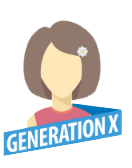Who Is Your Social Media Audience?
Published: September 14, 2022



 by Janet Bargewell, GiveDirect Support
by Janet Bargewell, GiveDirect Support
Finding your social media audience will help you formulate your GivingTuesday social media messaging and content. For example, will the message you use on one social channel be different than another? What does a Gen X giver look for vs. a Baby Boomer? Knowing who you are targeting will help your GivingTuesday strategy.
Let's Start With Your Audience

Who is it that you're trying to reach? Is it the professional, the soccer mom, or animal lover? Age, gender, education... The list can go on and on.
To focus in on a target audience, first you need to understand your goals. Your goals will ensure you prioritize your efforts and are focused on the people that matter most to you right now. And yes, your target audience might change over time, so focus on right now.
Is your goal right now to: increase donations; build your donor base; expand your volunteer list; double last year's event attendance? Organizational goals can change depending on the current campaign and audiences can change depending on your goal(s). This brings us back around to the question: Who is your target audience and how do you find them?
Audience Persona
Many experts suggest that you should first create an audience persona. This is important so as you draft your emails and create your posts you can talk to a specific person (persona) instead of an ambiguous, faceless audience. As a result, your communications will be more personal, relevant, and compelling.
A persona is a fictional representation of what a typical member of your target audience might "look" like. This includes a representation of their behavioral data coupled with your own personal knowledge of your supporters.

Typically, the persona will include things like:
- Demographics and background
- Preferred social media channels and methods of communication
- Their goals and challenges
- Their interests
- What motivates them to act
- How your nonprofit can help to solve their biggest challenges and support them to reach their goal
- Call to Action (what you want your audience members to do)
Here's an easy chart of questions to help you develop your target audience persona.
Social Media Demographics
Developing your audience persona includes knowing and understanding what social media platforms you will want to target for your specific audience.
Each platform is different and has its own set of pros and cons. (read more below)
You also need to think like your persona. A person on X is using that platform differently than a person on Pinterest or Snapchat.
| Platform | Monthly active users | Largest age group | Percentage of age group | Gender | Time spent per day | ||||||
|---|---|---|---|---|---|---|---|---|---|---|---|
| Male | Female | ||||||||||
| 2.91 billion | 25-34 | 31.5% | 43% | 57% | 33 min | ||||||
| Connects people by sharing content like posts, images, videos, and external links like blog posts. Users can contribute ideas and join conversations. | |||||||||||
| 2 billion | 25-34 | 31.2% | 48.4% | 51.8% | 29 min | ||||||
| Emphasizes photo and video sharing. | |||||||||||
| YouTube | 2+ billion | 15-35 | N/R | 46% | 54% | 30 min | |||||
| Video sharing service. Recent new features include Shorts, Live streaming, Chapters, Premieres and Community Tab. | |||||||||||
| Tik Tok | 1 billion | 10-19 | 25% | 43% | 57% | 89 min | |||||
| Social media platform for creating, sharing and viewing very short videos. | |||||||||||
| X | 211 million | 18-29 | 42% | 56.4% | 43.6% | 31 min | |||||
| Social networking site where users broadcast short posts known as tweets. Uses text, videos, photos or links. | |||||||||||
| 810 million | 25-34 | 58.4% | 48% | 52% | N/R | ||||||
| Professional network where users can connect with like-minded people. | |||||||||||
| 431 million | 50-64 | 38% | 22% | 78% | 14.2 min | ||||||
| Visual search engine filled with images tailored to specific user interests. Create and share pins. | |||||||||||
| Snapchat | 318 million | 15-25 | 48% | 54.4% | 44.6% | 25+ min | |||||
| Mobile messaging application used to share photos, videos, text, and drawings. | |||||||||||
| N/R = Not Reported | |||||||||||
Quick Social Media Facts:
- Facebook remains the largest social platform and is used by all but Gen Z.
- The youngest consumers gravitate to TikTok and Snapchat, but collectively use YouTube even more.
- Instagram is a favorite with Gen Z and Millennials.
- X is the only social platform with more male than female users.
- The largest demographic for Pinterest is Gen X and Boomers.
Generational Thinking
Another aspect of setting your persona is understanding the generational make-up and their social preferences.
The Baby Boomer Generation

- Birth Years: 1946 to 1964
- Current Age: 57 to 75
- Current Generation Size: 71.6 million
- Characteristics
- Hard-working, competitive, and self-reliant: Having been born during a period of high birth rates, boomers experienced more competition for schooling and jobs. They have lived through the civil rights movement, the Cold War, and the Vietnam War.
- Family and Finances: Boomers value strong family ties. They are financially stable with higher savings and disposable income. They buy products online more than other generations and favor products that give luxury and comfort or assist with health and nutrition.
- Education: 88.8% of Boomers have completed high school, and 28.5% hold a bachelor's degree or higher.
- Media: Boomers are the biggest consumers of traditional media like television, radio, magazines, and newspaper. Despite being so traditional, 90% of baby boomers have a Facebook account.
Generation X

- Birth Years: 1965 to 1979/80
- Current Age: 41 to 56
- Generation Size: 65.2 million (the smallest of the generational groups)
- Characteristics:
- Independent - also known as the latchkey generation. They can stand on their own and don't depend on anyone else to make the best of or to change their situation. They don't always have the brightest outlook on the future but are driven to make a difference.
- Flexible: They have lived through the end of the cold war and the rise of technology in their day-to-day world. They grew to be flexible and not only ready for change, but ready to force change as they question certain cultural practices.
- Family and Finances: Gen X-ers are in the middle of raising a family. Many are also taking care of aging parents. They value balance between work and family time. The average Gen X-er has approximately $140,000 in debt, though most of this is in their mortgage. They are looking to reduce their debt while building a stable savings plan for the future.
- Education: Generation X is better educated than previous generations with women being more educated (32.4% have a college degree) than their male counterpart.
- Media: Gen X-ers still read newspapers and magazines, listen to the radio, and watch approx. 165 hours of TV a month. Gen X-ers came of age with the internet and are digitally savvy. Approximately 75% of Gen X-ers use social networks, with Facebook dominating their usage, followed by YouTube.
Generation Y or Millennials

- Birth Years: 1981 to 1994/6
- Current Age: 25 to 40
- Generation Size: 72.1 million
- Characteristics:
- Confident: Millennials were raised to "Follow their dreams". As a result, many Millennials are motivated, and confident in themselves in a way not seen in prior generations. The first generation to be tightly scheduled as children, they feel driven (or pressured?) to succeed. They value group efforts and believe they are here to make the world a better place.
- Family and Finances: This generation entered the workforce and began wealth accumulation later than Baby Boomers but is expected to outspend Boomers.
- Education: One-third have earned at least a bachelor's degree. They carry more student debt than ever before.
- Media: Many Millennials still watch TV but prefer Netflix and streaming. This generation is extremely comfortable with mobile devices. They typically have multiple social media accounts.
Generation Z or Zoomers

- Birth Years: 1997 to 2012
- Current Age: 9 to 24
- Generation Size: 68 million
- Characteristics:
- Safety and (in)security: You might call this the insecure generation. They have grown up with terrorism, extremism, and global warming. They were born right before the financial crisis and resulting recession. Their earliest memories might include financial upheaval and job loss for their family members.
- Accepting: Zoomers are growing up in a world where tolerance is expected and diversity is welcomed.
- Media: The average Zoomer received their first mobile phone at approximately 10 years of age. The smartphone is their preferred method of communication. On average, they spend 3 hours a day on their mobile device.
- Education: The statistics for this group are still in the making, but it appears that Zoomers are less focused on a four-year institutional degree and more focused on technical and trade skills.
Summary
An effective GivingTuesday social media strategy starts with identifying a target audience(s).
It's important to develop an audience persona that will help you focus your campaign and communications. To do this you need to:
- Use the Audience Persona Development chart to help you develop your audience persona.
- Review the Social Media Demographics chart to help you decide which platforms to include in your social media communications strategy.
- Understand generational differences to help you develop an audience persona and tailor your message to "land" with that persona.
We understand this is a lot and will take time to develop. But to fully develop your campaign and engage the correct audience, you must understand who and where your audience is.